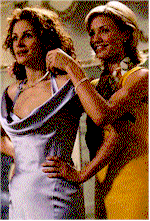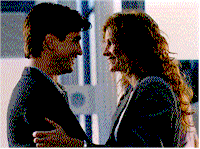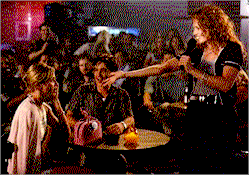|
| |
My Best Friend's Wedding
Review by Carrie
Gorringe
Posted 20 June 1997
 |
|
Directed by P.J. Hogan
Starring Julia Roberts, Dermot Mulroney,
Cameron Diaz, Rupert Everett,
and J.T. Walsh
Screenplay by Ronald Bass |
Noted food critic Julianne
Potter, (Roberts), "Jules" to her friends, is about to experience first hand the
horrible truth to the homily about being very careful for what you ask, because you just
might receive it. Her former lover and now best friend, Michael O’Neal (Mulroney) is
about to get married. "Best Friends", however, does not even begin to describe
the relationship between Michael and Jules; after one "hot month" in college, as
Jules describes it, she and Michael decided to be friends instead. This friendship
transcended the usual guilt-ridden, uncomfortable moments between two ex-lovers who decide
upon so-called friendship as an excuse to avoid hurt pride on either side of the fence.
These two really are the best of friends – true confidantes and advisers with a level
of mutual trust and affection that is enviable, to say the least, if a touch obsessive.
During the nine years of their friendship, Michael had always carried a bit of a torch for
Jules, to the point where, the year earlier, he had obliged her to vow that the two of
them would marry if neither one was married by the age of twenty-eight. Jules is down to
three weeks before her deadline when Michael pops the question – to someone else.
That someone is Kimmy, (Diaz), a sweet student of architecture from an indecently wealthy
family. She embraces Jules from the first as a sister. But Jules, learning too late that
she really does love Michael, detects enough weaknesses in Kimmy and Michael’s
relationship to make covert sabotage a reality. All sorts of madcap situations ensue, even
to the point of recruiting Jules’ gay editor, George (Everett), to pose as her
fiancé, a disguise that he pulls off so brilliantly that Michael begins to get jealous.
 The audience for My Best Friend’s Wedding, as evinced above, will
find themselves firmly in the ‘30s screwball realm of It Happened One Night.
There are a few departures from the basic formula, one of them being a heroine who is
rushing toward matrimony from the start rather than fleeing from it (indeed, so prevalent
was this premise that one of the best books on this romantic comedy genre is entitled The
Runaway Bride). Screenwriter Bass, who won an Oscar for the screenplay of Rain Man,
has provided audiences with the best justification in recent memory for resurrecting the
screwball comedy. Bass is on firmer ground with this genre than the other recent entry in
the genre, the dreary Addicted to Love. The difference
between the two is easy to distinguish: Bass refuses to let the central obsessions between
the characters -- the most delicate and critical element of this type of comedy -- descend
into overt cruelty. The characters’ actions may seem nasty to outsiders, but,
paradoxically, the characters must be constructed with enough likeable qualities that, by
the time they commence their outrageous behavior, it is seen to be entirely normal. In
contrast, Addicted to Love was completely undone by the well-over-the-borderline
psychopathy of the lead heroine; as written, Maggie was too hateful to be sympathetic.
Moreover, the insecurities of Broderick and Ryan’s alter egos were far too
extensively ingrained to render them effective objects of identification for anyone except
chronic milquetoasts or stalkers-in-training. According to Elizabeth Kendall (she of The
Runaway Bride), the best screwball characters had at their very souls an irresistible
mixture of self-confidence and emotional vulnerability. Michael and Jules are both
successful and happy in their lives; all they need is someone to share those lives with.
There is relatively little malice aforethought at work in Jules’ obsession with
derailing the wedding; it has less to do with exorcising deep-seated personal demons and
more to do with securing her happiness. The seemingly inexorable fact that a wedding is
about to take place is, at best, a trifling concern compared with the need to assure
herself of Michael’s love, a gift she now needs to rescue from her neglect. The audience for My Best Friend’s Wedding, as evinced above, will
find themselves firmly in the ‘30s screwball realm of It Happened One Night.
There are a few departures from the basic formula, one of them being a heroine who is
rushing toward matrimony from the start rather than fleeing from it (indeed, so prevalent
was this premise that one of the best books on this romantic comedy genre is entitled The
Runaway Bride). Screenwriter Bass, who won an Oscar for the screenplay of Rain Man,
has provided audiences with the best justification in recent memory for resurrecting the
screwball comedy. Bass is on firmer ground with this genre than the other recent entry in
the genre, the dreary Addicted to Love. The difference
between the two is easy to distinguish: Bass refuses to let the central obsessions between
the characters -- the most delicate and critical element of this type of comedy -- descend
into overt cruelty. The characters’ actions may seem nasty to outsiders, but,
paradoxically, the characters must be constructed with enough likeable qualities that, by
the time they commence their outrageous behavior, it is seen to be entirely normal. In
contrast, Addicted to Love was completely undone by the well-over-the-borderline
psychopathy of the lead heroine; as written, Maggie was too hateful to be sympathetic.
Moreover, the insecurities of Broderick and Ryan’s alter egos were far too
extensively ingrained to render them effective objects of identification for anyone except
chronic milquetoasts or stalkers-in-training. According to Elizabeth Kendall (she of The
Runaway Bride), the best screwball characters had at their very souls an irresistible
mixture of self-confidence and emotional vulnerability. Michael and Jules are both
successful and happy in their lives; all they need is someone to share those lives with.
There is relatively little malice aforethought at work in Jules’ obsession with
derailing the wedding; it has less to do with exorcising deep-seated personal demons and
more to do with securing her happiness. The seemingly inexorable fact that a wedding is
about to take place is, at best, a trifling concern compared with the need to assure
herself of Michael’s love, a gift she now needs to rescue from her neglect.
 The other precondition for screwball comedy is to have at hand a cast with an
immaculate sense of timing, and Hogan chose his cast well. It is not enough to say that
there are no false notes on screen; one must judge the acting here within the realm of
varying degrees of excellence. Roberts and Mulroney add such sweetness to their desperate,
confused feelings for each other so to make the audience believe that there is truly
something valuable at stake here. Diaz, who seems to specialize in hard-boiled white trash
(Feeling Minnesota) blossoms into a fine comedienne in her role as Kimmy; she transforms
her role as comic foil into something far more than it could have been. The real star
here, nevertheless, is Everett, whose charm and sexuality is almost tangible, to the point
where those insidious, "what-a-shame-he’s-gay" thoughts cross your mind
more than once. Why Jules would go for Michael’s shaggy-dog routine over
George’s urbane sexiness (other than the minor sexual-orientation problem) is a
mystery. The other precondition for screwball comedy is to have at hand a cast with an
immaculate sense of timing, and Hogan chose his cast well. It is not enough to say that
there are no false notes on screen; one must judge the acting here within the realm of
varying degrees of excellence. Roberts and Mulroney add such sweetness to their desperate,
confused feelings for each other so to make the audience believe that there is truly
something valuable at stake here. Diaz, who seems to specialize in hard-boiled white trash
(Feeling Minnesota) blossoms into a fine comedienne in her role as Kimmy; she transforms
her role as comic foil into something far more than it could have been. The real star
here, nevertheless, is Everett, whose charm and sexuality is almost tangible, to the point
where those insidious, "what-a-shame-he’s-gay" thoughts cross your mind
more than once. Why Jules would go for Michael’s shaggy-dog routine over
George’s urbane sexiness (other than the minor sexual-orientation problem) is a
mystery.
And, yet, there is a serious problem with My Best Friend’s Wedding,
situated primarily in the ending. Not wanting to give too much away, I’ll reveal only
that the variation on the usual state of affairs in such films is so far out in left field
in this case as to be nothing less than shocking -- almost dangerously so. Fortunately,
Bass carefully wrote a coda to the entire proceedings which eases the transition more or
less, depending upon how much of an aficionado an audience member is of the screwball
comedy. This business of the ending is not a serious issue, but it may set you back
temporarily.
 Despite this one potential flaw, the film redeems itself through its delirious
sense of how to recombine pop-culture elements, and the soundtrack is its crowning glory.
The opening credits, with their loopy take on the pop classic Wishin’ And
Hopin’, made famous by Dusty Springfield (here sung, or whispered, less
persuasively by Ani Defranco), and their liberal use of crane shots and geometric patterns
owes as much to Busby Berkeley as to Hal David and Burt Bacharach. The soundtrack of this
film, in fact, is almost a repertoire of David and Bacharach compositions, from the
aforementioned Wishin’ to Do You Know The Way To San Jose and What
the World Needs Now Is Love. From the sing-along conducted at the seafood restaurant
-- to the tune of I Say A Little Prayer -- one might conclude that Hal David and
Burt Bacharach have become the late twentieth-century’s answer to Stephen Foster. A
new appreciation of the 60’s David-Bacharach standards has emerged (if an article in
the July 1997 edition of The Atlantic Monthly is any indicator of current trends)
as perhaps the last time in modern memory that the combination of hummable melodies with
universal, if simplistic, themes enjoyed any common vogue. Hogan has made a habit of
resurrecting vintage musical groups currently out of public favor; he employed the same
motif in her breakthrough film, Muriel’s Wedding, introducing impressionable
minds to (some might say, "corrupting with") the disco-era treacle known to
lovers of platform shoes and white polyester everywhere as ABBA. Hogan does, however, have
the good taste to include the Dorothy Fields-Jerome Kern classic, The Way You Look
Tonight ( yet another link between this film and its genre past: a song from the 1936
Astaire-Rogers musical romantic comedy, Swing Time) and even some Rachmaninoff, in
an indiscriminate, if evocative, audio mix, which is, apparently, Hogan’s trademark.
The mix is indiscriminate only in selections, but never in practice; it is never used
obtrusively, nor as a substitute for distracting the audience from bad writing. It is, in
fact, a metaphor for Hogan’s work: simple themes handled skillfully. Throw this film
a bouquet for its audacious reapplication and reinvention of the nearly-contemptibly
familiar. Despite this one potential flaw, the film redeems itself through its delirious
sense of how to recombine pop-culture elements, and the soundtrack is its crowning glory.
The opening credits, with their loopy take on the pop classic Wishin’ And
Hopin’, made famous by Dusty Springfield (here sung, or whispered, less
persuasively by Ani Defranco), and their liberal use of crane shots and geometric patterns
owes as much to Busby Berkeley as to Hal David and Burt Bacharach. The soundtrack of this
film, in fact, is almost a repertoire of David and Bacharach compositions, from the
aforementioned Wishin’ to Do You Know The Way To San Jose and What
the World Needs Now Is Love. From the sing-along conducted at the seafood restaurant
-- to the tune of I Say A Little Prayer -- one might conclude that Hal David and
Burt Bacharach have become the late twentieth-century’s answer to Stephen Foster. A
new appreciation of the 60’s David-Bacharach standards has emerged (if an article in
the July 1997 edition of The Atlantic Monthly is any indicator of current trends)
as perhaps the last time in modern memory that the combination of hummable melodies with
universal, if simplistic, themes enjoyed any common vogue. Hogan has made a habit of
resurrecting vintage musical groups currently out of public favor; he employed the same
motif in her breakthrough film, Muriel’s Wedding, introducing impressionable
minds to (some might say, "corrupting with") the disco-era treacle known to
lovers of platform shoes and white polyester everywhere as ABBA. Hogan does, however, have
the good taste to include the Dorothy Fields-Jerome Kern classic, The Way You Look
Tonight ( yet another link between this film and its genre past: a song from the 1936
Astaire-Rogers musical romantic comedy, Swing Time) and even some Rachmaninoff, in
an indiscriminate, if evocative, audio mix, which is, apparently, Hogan’s trademark.
The mix is indiscriminate only in selections, but never in practice; it is never used
obtrusively, nor as a substitute for distracting the audience from bad writing. It is, in
fact, a metaphor for Hogan’s work: simple themes handled skillfully. Throw this film
a bouquet for its audacious reapplication and reinvention of the nearly-contemptibly
familiar.
Contents | Features
| Reviews | News | Archives | Store
Copyright © 1999 by Nitrate Productions, Inc. All Rights
Reserved.
| |
|